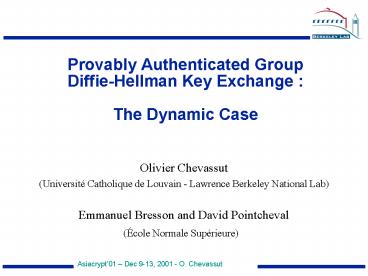Provably Authenticated Group DiffieHellman Key Exchange : The Dynamic Case PowerPoint PPT Presentation
1 / 15
Title: Provably Authenticated Group DiffieHellman Key Exchange : The Dynamic Case
1
Provably Authenticated Group Diffie-Hellman Key
Exchange The Dynamic Case
- Olivier Chevassut
- (Université Catholique de Louvain - Lawrence
Berkeley National Lab) - Emmanuel Bresson and David Pointcheval
- (École Normale Supérieure)
2
Outline
- Motivation
- The Problem
- Related Work
- Security Model
- Security Definitions
- A Secure Authenticated Group Diffie-Hellman
Protocol - Security Theorem
- Conclusion
3
Motivation
- An increasing number of distributed applications
need to communicate within groups, e.g. - collaboration and videoconferencing tools
- replicated servers
- stock market and air traffic control
- distributed computations (Grids)
- An increasing number of applications have
security requirements - privacy of data
- protection from hackers (public network)
- protection from viruses and trojan horses
- Group communication must address security needs
4
The Problem
- Group Diffie-Hellman Characteristics
- group relative small (up to 100 members)
- no centralized server
- members have similar computing power
- membership is dynamic (members join and leave the
group at any time) - Goals for Group Key Exchange
- Authenticated Key Exchange (AKE)
- implicit authentication only the intended
partners can compute sk - semantic security a session key is
indistinguishable from a random string - Mutual Authentication (MA)
5
Prior Work The Static Case
- Provably Authenticated Group DH Key Exchange,
ACM CCS01 - static membership (all the members join the group
at once) - model of computation in the Bellare-Rogaway style
- players are modeled via oracles
- adversary controls all interactions among the
players - adversarys capabilities are modeled by queries
to the oracles - adversary plays a game against the players
- an authenticated group Diffie-Hellman key
exchange protocol
6
Model of Communication
- A set of n players
- each player is represented by an oracle
- each player holds a long-lived key (LL)
- A multicast group consisting of a set of players
LL1
LL2
Multicast Group with sk
LL3
LL4
7
Modeling the Adversary
- Adversarys capabilities modeled through queries
- setup initialize the multicast group
- remove remove players from multicast group
- join add players to the multicast group
LL1
LL2
setup
join
remove
LL4
LL3
8
Freshness Related Queries
sk is Fresh if it is known by the players but not
the adversary
(LL)
reveal
(sk)
corrupt
9
Security Definitions (AKE)
Public data
PROTOCOL
. . .
Test a fresh sk
Flip a coin b
sk if b1, random if b0
. . .
Outputs b guess for b
10
A Secure Authenticated Group Diffie-Hellman
Protocol
- The session key is
- skH(gx1x2xn)
- Ring-Based with flows
- Defined by three algorithms
- SETUP
- REMOVE
- JOIN
- Many details abstracted out
11
The SETUP Algorithm
- Up-flow Ui raises received values to the power
of xi and forwards to Ui1 - Down-flow Un processes the last up-flow and
broadcasts
g, gx1
x2
x1
gx2, gx1, gx1x2
gx2x3 ,
gx1x3
skH(gx1x2x3)
x3
12
The REMOVE Algorithm
- Down-flow of the SETUP algorithm
gx2x3
x1
x3
13
The JOIN Algorithm
- SETUP initiated by player with highest index in
group (Ugc)
Ugc
x2
x1
gx2x3x4 , gx1x3x4, gx1x2x4
x4
gx2x3, gx1x3, gx1x2, gx1x2x3
14
Security Theorem (AKE)
- Random-oracle assumption
- Theorem
- Advake(T,Q,qs,qh) ? 2 n Succcma(T )
2 Q (ns) s qh Succgcdh(T ) - T,T ? T (Qqs) n Texp(k)
- Adversary breaks AKE in two ways
- (1) assume that the adversary forges a signature
w.r.t some player s LL-key gt it is possible to
build a forger - (2) asume that the adversary is able to guess the
bit b involved in the Test-query - gt it is possible to come up with an algo that
solves an instance of the Group Diffie-Hellman
problem
15
Conclusion and Future Work
- Summary
- A security model for the dynamic case
- A secure protocol
- A proof of security in the random-oracle model
- Limitations
- sequential executions only
- random-oracle assumption
- Concurrent Executions for Authenticated Dynamic
Group DH Key Exchange using Crypto-Devices, Work
in Progress - concurrent executions
- standard model
- weak-corruption and strong-corruption models

